Sixteenth Century
A Five-Year Pregnancy
According to a sixteenth-century legend, recounted in the 1560 manuscript Histoires Prodigieuses by Pierre Boaistau, there once was a woman who suffered through a five-year pregnancy. Here's the story as summarized by Dr. Irvine Loudon in the Journal of the Royal Society of Medicine (May 2003):Some days later, feeling her pains return, Marguerite summoned a series of most eminent doctors from far and wide, imploring their help. The doctors merely gave her a series of drugs but with no effect. Marguerite therefore 'resolved to let nature take its course and bore with exceeding pain for the space of four years this dead corpse in her stomach'. In the fifth year she finally persuaded a surgeon to open her up and remove the child which was 'half rotted away'. The operation took place on 12 November 1550. Marguerite soon recovered and was 'so full of life and so healthy that she can still [i.e. in 1559] conceive children'.

"The operation on Marguerite of Vienna"
As unlikely as the story may sound, Dr. Loudon argues that it could be true:
It may be that Marguerite’s dead baby was never delivered vaginally because it was never in the uterus. Being shut off, so to speak, from the outside world, a dead baby could have escaped being the source of an infection...
In this case, when a surgeon finally agreed to operate, he did not perform a caesarean section; he simply opened the abdominal wall and promptly saw and removed the remnants of the baby. The placenta would not have been a problem because in abdominal ectopics if the baby dies the placenta soon shrivels and can be left intact. This one had five years to shrivel.
Posted By: Alex - Sat Nov 09, 2024 -
Comments (0)
Category: Medicine, Surgery, Medieval Era, Sixteenth Century, Pregnancy
Death by Drama
Paul posted last week about a real-life murder that occurred onstage during a play. This reminded me of another onstage death I once read about in Jody Enders' book Death By Drama and Other Medieval Urban Legends.The death is said to have occurred in 1549, during a performance of the play Judith and Holofernes, which tells the Biblical (or Biblical apocrypha) story of Judith who cuts off the head of an Assyrian general, Holofernes. The producers of the play supposedly decided it would add a touch of realism if the actor playing Holofernes really was decapitated.
The details from Enders' book:
Jean de Bury and Jean de Crehan, duly charged with decorating the streets, had imagined rendering in its purest form the biblical exploit of Judith. Consequently, for filling the role of Holofernes, a criminal had been chosen who had been condemned to have his flesh torn with red-hot pincers. This poor fellow, guilty of several murders and ensconced in heresy, had preferred decapitation to the horrible torture to which he had been condemned, hoping, perhaps, that a young girl would have neither the force nor the courage to cut off his head. But the organizers, having had the same concern, had substituted for the real Judith a young man who had been condemned to banishment and to whom a pardon was promised if he played his role well.
The story goes that the two substitutions were accepted by the two unnamed men. Being an actor / executioner was apparently preferable to being banished, and death by decapitation during drama was preferable to being skinned alive (something that the Eel of Melun might himself have understood).
"Judith" had only one condition to meet: to provide acting so good that it wasn't acting at all. . .
The fantastic narrative next shows Philip arriving just as the axe is falling. As real blood supposedly begins to flow, it prompts applause in some, indignation in others, and curiosity in the prince, who remains implacable as the body of "Holofernes" goes through its last spasms:
In fact, as Philip approached the theater where the mystery play was being represented, the so-called Judith unsheathed a well-sharpened scimitar and, seizing the hair of Holofernes, who was pretending to be asleep, dealt him a single blow with so much skill and vigor that his head was separated from his body. At the [sight of] the streams of blood that spurted out from the neck of the victim, frenetic applause and cries of indignation rose up from amid the spectators. Only the young prince remained impassive, observing the convulsions of the decapitated man with curiosity and saying to his noble entourage: "nice blow".

Enders has doubts this onstage execution ever really took place, but can't rule out the possibility altogether.
In the story's favor: Philip II really did go to Tournai in 1549; Jehan de Crehan was a real person; there really were plays performed in Philip's honor; and Tournai had a history of executing heretics, and of offering decapitation as a "kinder" alternative to more gruesome forms of execution.
The points against the story's veracity: not a single, extant contemporaneous source mentions this onstage decapitation. The first references to it only appear several hundred years later. And it stretches credulity to imagine that a condemned prisoner would obligingly play his part in the performance, even to the extent of pretending to be asleep before he was decapitated.

Posted By: Alex - Fri Mar 18, 2022 -
Comments (4)
Category: Death, Theater and Stage, Fables, Myths, Urban Legends, Rumors, Water-Cooler Lore, Sixteenth Century
Hamlet, the Rock Musical
Posted By: Paul - Tue Mar 03, 2020 -
Comments (0)
Category: Beauty, Ugliness and Other Aesthetic Issues, Costumes and Masks, Death, Ineptness, Crudity, Talentlessness, Kitsch, and Bad Art, Pranks and Revenge, Theater and Stage, Homages, Pastiches, Tributes and Borrowings, Pop Art, Foreign Customs, Seventeenth Century, Sixteenth Century, Brain Damage, Cacophony, Dissonance, White Noise and Other Sonic Assaults
The Monk Calf of Freiberg
I don't recall any of this being discussed in October 2017 on the 500th anniversary of the Reformation.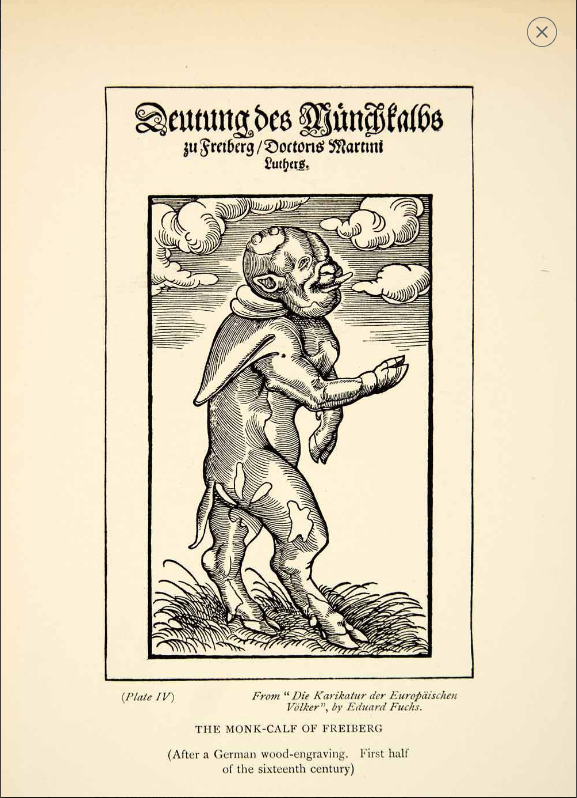
A misshapen calf, born in Freiberg, Saxony, on 8 December 1522, quickly became important in the German Reformation. It was born with oddly shaped legs (its hind legs straight as a human's) and with a fold of skin over its head shaped like a cowl—hence its comparison to a monk. An illustration made its way to a Prague astrologer, who "discovered that the monster did indeed signify something terrible, indeed the most awful thing possible--Martin Luther."[10] Luther himself responded quickly with a pamphlet containing a mock exegesis of the creature, Monk Calf, in which the "Monk Calf" stands, in all its monstrosity, for the Catholic church.[12] Luther's anti-papist pamphlet appeared together with a tract by Philipp Melanchthon[13] which discussed a fictional monster, the Pope-Ass, a hybrid between a man and a donkey supposedly found near Rome after the 1496 flood.[14] Circulated in 1523, Martin Luther and Philipp Melanchthon's pamphlet was titled The Meaning of Two Horrific Figures, the Papal Ass at Rome and the Monk Calf Found at Freyberg in Meissen.[15] Luca Cranach the Elder and his workshop provided the illustrations of the Papal Ass and the Monk Calf for the pamphlet. Variations of Luther and Melanchthon’s pamphlet eventually were circulated, including one that depicted the Papal Ass and the Monk Calf in “an encounter between the two creatures. This opening page adds a new phrase to the title of the book: ‘with signs of the Day of Judgement.'"[16]
Source.
Posted By: Paul - Tue Jul 31, 2018 -
Comments (1)
Category: Anniversary, Religion, Europe, Sixteenth Century, Fictional Monsters
The Horned Helmet of Henry VIII
Pix and text here.
Posted By: Paul - Sun Feb 18, 2018 -
Comments (0)
Category: Technology, War, Weapons, Sixteenth Century
Trompe l’oeil in the Villa Barbaro
Wikipedia entry here.
Posted By: Paul - Fri Sep 25, 2015 -
Comments (2)
Category: Architecture, Art, Europe, Sixteenth Century
Theodor de Bry
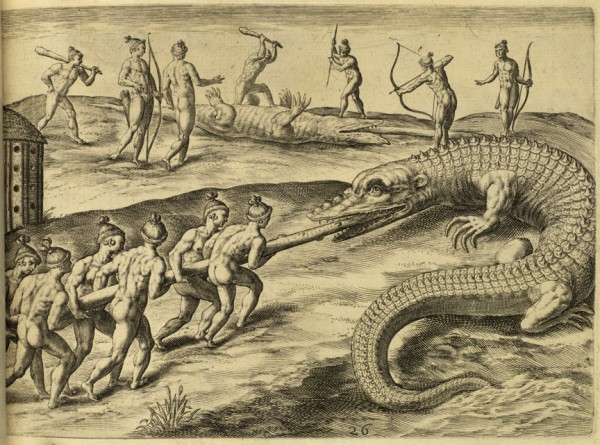
[Click to enlarge]
I love the almost-human arms and legs on this enormous alligator, which is being attacked, ostensibly, by Native Americans, as depicted by 16th-century artist Theodor de Bry.
"The verisimilitude of many of de Bry's illustrations is questionable; not least because he never crossed the Atlantic. "
Posted By: Paul - Wed May 14, 2014 -
Comments (10)
Category: Animals, Art, Europe, North America, Sixteenth Century
The Rib of James V
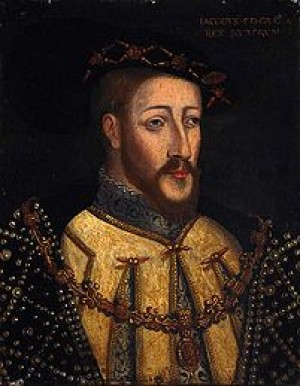
Wikipedia page.
Doctor Robert Honeyman of Scotland left his son a human rib from King James V. Why? Well, wouldn't you?
To son Robrt [sic] Bruce Honeyman, 900 acres whereon testator resides, negroes (men Bob, John, boy Lewis, deaf & dumb woman Celia & her children Murvin & Beck), 2 work horses, 4 work oxen, 4 cows/calves, 20 sheep, all hogs, farming/kitchen utensils, all furniture in house, all books (except 10 vol to each dau [sic]), watch, guns, all medicines/surgical instruments, microscopes (except best in shagreen case to son), thermometer, diploma, human rib (of James V, King Scotland) in small trunk in chest...
Source.
More information:
Among the early settlers of Lauderdale County were Dr. Samuel and Cornelia C. (Honyman) Oldham; her father, Dr. Robt. Honyman [sic], was a noted physician and member of the royal navy, for many years surgeon of the "Portland," a ship of the line, that was sent to St. Helena in 1771, to await Capt. Cook's expected arrival from his first trip around the world, and convey his ship to England. He was also a direct descendant of the Dr. Honyman, who extracted by command, the fifth rib from the side of James V, King of Scotland, which rib was transmitted to him by his ancestors, and he by will to his only son, with the request, "that he will carefully keep the said rib, and carefully transmit it to his descendants."
Source.
Finally:

Source.
Posted By: Paul - Tue Mar 18, 2014 -
Comments (6)
Category: Children, Parents, Sixteenth Century, Skulls, Bones and Skeletons
The Mermen of Johann Zahn
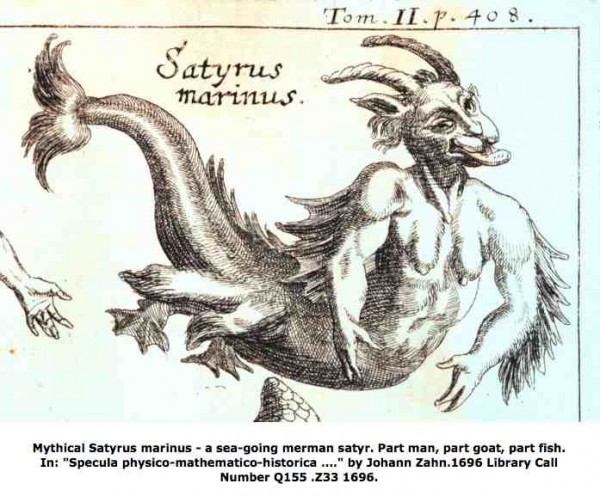

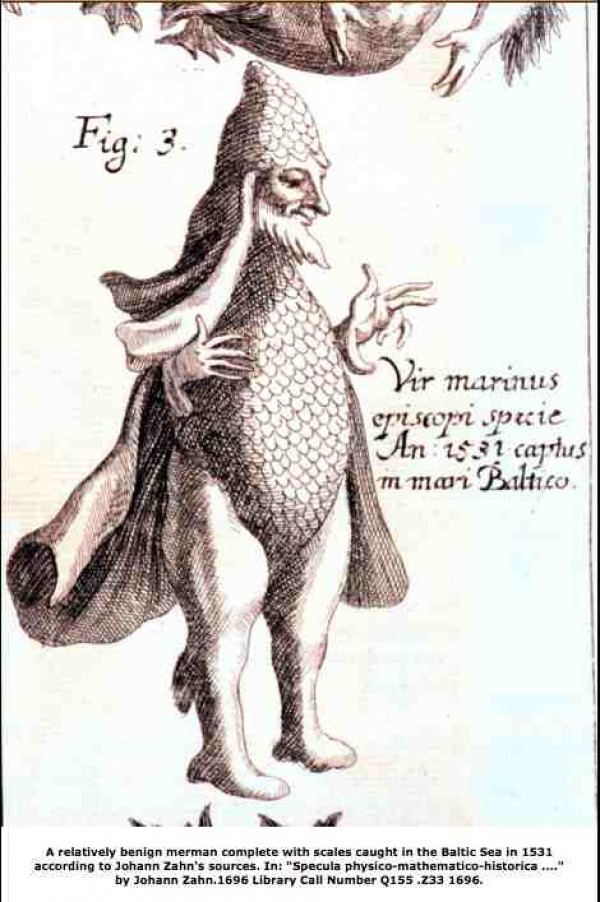
Wikipedia page of Johann Zahn.
Images from the NOAA archives.
Posted By: Paul - Fri Jan 24, 2014 -
Comments (3)
Category: Cryptozoology, Europe, Sixteenth Century
How To Carve An Elephant
An illustration for this purpose can be found in a sixteenth-century edition of De Arte Coquinaria (On the Subject of Cooking).
A 1905 article in the Strand magazine provides more info about this work:
The work is divided into ten books, beginning with soups, pickles, and sauces, and proceeding through the whole art of cookery, with hundreds of recipes, the very reading of which makes one's mouth water. For instance, who could resist "virgin sow drest with broth made of pepper, wine, honey, oyl, and stew'd damsons"? Or dormouse sausages? ...
There are many recipes in the book to dress "cramp-fish, that numb the hands of those that touch them; the cuttlefish, whose blood is like ink; the pourcontrel, or many feet, the sea-urchin or hedgehog." ...
Then, again, we are given minute instructions for the carving of beasts whose flesh was esteemed by the ancients. "In partes of Asia and Africa," we are told, "the oliphant is eaten, not as the Romans and Egyptians were wont to do, sparingly and only as pertain'd to his feete, trunk, and tayle all of which were great delicacies, but his entire carcase is carved and consumed." For the benefit of those who might happen to possess an elephant and be tempted to eat him a chart of carving instructions accompanies the text.
Posted By: Alex - Wed Dec 12, 2012 -
Comments (5)
Category: Animals, Food, Books, Sixteenth Century

| Who We Are |
|---|
| Alex Boese Alex is the creator and curator of the Museum of Hoaxes. He's also the author of various weird, non-fiction, science-themed books such as Elephants on Acid and Psychedelic Apes. Paul Di Filippo Paul has been paid to put weird ideas into fictional form for over thirty years, in his career as a noted science fiction writer. He has recently begun blogging on many curious topics with three fellow writers at The Inferior 4+1. Contact Us |




